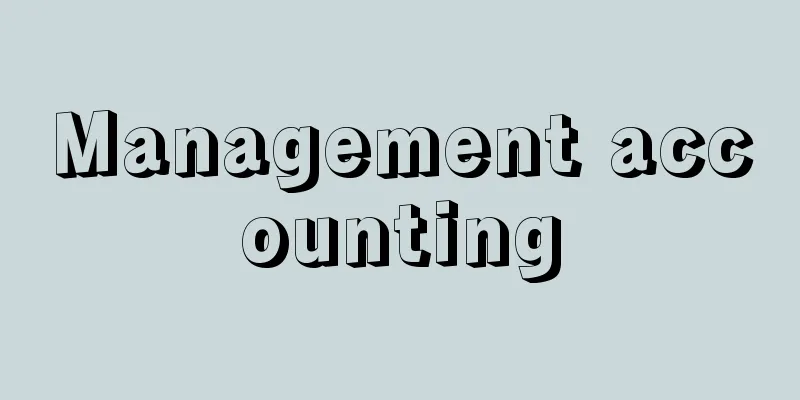Management accounting

|
Along with financial accounting, they constitute the two major areas of corporate accounting. While financial accounting's main research theme is the theory of creating financial statements to be reported to external stakeholders (such as shareholders), management accounting studies the methods of creating accounting information or data that contributes to the management activities of the company's internal executives or managers. It is also called internal reporting accounting. [Tokai Mikio] HistoryThe establishment of management accounting, which is contrasted with financial accounting as we see it today, is inseparably linked to the development of cost accounting. In other words, the 19th century Western economies, which had undergone the industrial revolution, laid the foundation for the establishment of cost accounting with overhead allocation due to the expansion of business scale through advanced capital investment strategies. Then, combined with F. W. Taylor's ideas on scientific management in the early 20th century, the standard cost accounting system was established as a cost control tool including advance calculation, and further budget control (later budget management) was established as a comprehensive control method, forming the basis of management accounting theory. After that, the recession after World War I was an important opportunity to introduce the core techniques of today's management accounting techniques, such as break-even analysis, direct costing, and variable budgeting. After World War II, the interdisciplinary combination of mathematics, statistics, and even psychology has shown remarkable development in methods of future calculation, such as decision-making. [Tokai Mikio] systemManagement accounting can be systematized as follows based on different perspectives: (1) Based on the area of application, it is classified into manufacturing management accounting, sales management accounting, financial management accounting, research and development management accounting, logistics management accounting, etc. (2) Based on management function, accounting is divided into planning accounting and control accounting. (3) Based on the management content, it is divided into decision-making accounting and performance management accounting. The systematization of (1) is something that is naturally required in the practice of management accounting and is easy to understand. On the other hand, (2) and (3) are closely related in terms of how to separate the substance of management. Decision-making accounting aims to provide useful accounting data that is useful for various decision-making at all levels of management, and is divided into long-term, strategic, structural accounting, centered on capital investment planning, and short-term, tactical, routine accounting, such as product mix and custom price setting. Performance management accounting, on the other hand, is a fairly systematic accounting methodology, usually based on a period of one year, ranging from budget compilation as pre-calculation to variance analysis and performance evaluation as post-calculation. This accounting method is more effective by closely linking accounting data for performance management with authority and responsibility within the organization, and is specifically called responsibility accounting. [Tokai Mikio] techniqueStandard cost accounting is the oldest management accounting technique, but since the 1980s, this cost management technique has evolved the concept and method of cost planning by applying engineering knowledge such as VA (value analysis) and VE (value engineering). This is an attempt to narrow down costs as much as possible at the planning and design stage. In addition, break-even analysis based on cost decomposition into variable and fixed costs, direct costing, and contribution margin methods are used as important techniques for profit management. In this analysis, too, progress has been made in business mathematics such as LP (linear programming), and it is effectively used for combinatorial problems. For long-term decision-making problems, the focus is on economic calculations of capital investments, such as the return on investment method, net present value method, and payback period method, assuming the present value discounting of cash flows. In a bid to truly modernize management accounting, they have developed Activity Based Costing (ABC) and its advanced form, Activity Based Management (ABM), and, in their search for a comprehensive direction for performance management, they have even developed methods that oversee corporate management as a whole, such as the Balanced Scorecard (BSC). [Tokai Mikio] "Management Accounting, 3rd Edition, by Michiharu Sakurai (2004, Dobunkan Publishing)" ▽ "Cost Accounting and Management Accounting for the Accounting Profession - Enabling Sustainable Growth and Development of Companies, by Mikio Tokai (2007, Seibunsha)" ▽ "Management Accounting, 2nd Edition, by Kiyoshi Okamoto, Toshiro Hiromoto, Yutaka Obata, and Fumiko Hibiki (2008, Chuo Keizaisha)" ▽ "Introduction to Management Accounting, by Yutaka Kato (Nikkei Bunko)" [References] | | | | | | | | | | |Source: Shogakukan Encyclopedia Nipponica About Encyclopedia Nipponica Information | Legend |
|
財務会計とともに企業会計の二大領域を構成している。財務会計が企業外部の利害関係者(株主など)に対して報告する財務諸表の作成理論を主たる研究テーマとしているのに対して、管理会計は、企業内部の経営者あるいは管理者のマネジメント活動に資する会計情報あるいはデータの作成方法を研究する。内部報告会計ともよばれる。 [東海幹夫] 沿革今日のように財務会計と対置させる管理会計の成立は、原価計算の発展と不可分の関係にある。すなわち、産業革命期を経た19世紀の欧米経済は、高度な設備投資戦略による経営規模の拡大により間接費配賦を伴う原価計算を確立させる基盤をつくった。そして、20世紀初頭のF・W・テーラーの科学的管理法の思想と相まって、事前計算を含むコスト・コントロール用具として標準原価計算制度を、さらには包括的コントロール手法としての予算統制(後の予算管理)を成立させ、管理会計論の基盤をつくった。その後、第一次世界大戦後の不況期を経たことを重要な契機として、損益分岐点分析、直接原価計算、変動予算など、今日の管理会計技法の中心的テクニックを導入することになった。第二次世界大戦後は、数学、統計学、さらには心理学などとの学際的結合により、意思決定など未来計算の手法に目覚ましい発展を示している。 [東海幹夫] 体系管理会計は、観点の相違によって次のように体系化することができる。 (1)適応領域別に、製造管理会計、販売管理会計、財務管理会計、研究開発管理会計、物流管理会計などに区分する。 (2)マネジメント機能別に、計画会計と統制会計とに区分する。 (3)マネジメント内容別に、意思決定会計と業績管理会計とに区分する。 (1)の体系化は、管理会計の実践上、自発的に要請されるものであり、わかりやすい。これに対して(2)と(3)は、マネジメントの内実をどのように切断するかという点で密接な関係をもつものである。 意思決定会計とは、経営管理者各階層において行われるさまざまな意思決定に役だつ有益な会計データの提供を目的とし、設備投資計画を中心とする長期的、戦略的、基本構造的な特徴をもつものと、製品の組合せや特注価格の設定問題などの短期的、戦術的、日常業務的な特徴をもつものとに区別される。一方、業績管理会計は、事前計算としての予算編成から事後計算としての差異分析や業績評価などまで、通常は1年間といった期間を基礎としたかなり制度的な性格をもった会計である。この会計は、業績管理上の会計データと組織における権限と責任とを密接に関係づけることによって、より大きな効果を発揮し、これをとくに責任会計と称している。 [東海幹夫] 技法管理会計技法のうちもっとも古くから利用されている技法は標準原価計算であるが、このような原価管理上の手法は、1980年代ころから、VA(バリュー・アナリシスvalue analysis=価値分析)、VE(バリュー・エンジニアリングvalue engineering=価値工学)など工学系の知識を応用しながら、原価企画の概念・手法を進化させている。これは、原価の絞込み活動を、できる限り企画・設計段階で達成しようとするものである。また、変動費と固定費のコスト分解を基盤とする損益分岐点分析や直接原価計算、貢献利益法などが、利益管理上の重要な技法として活用されている。この分析でも、LP(リニア・プログラミングlinear programming=線形計画法)のような経営数学の発展との接近が図られ、組合せ問題などに有効利用されている。長期的な意思決定問題では、キャッシュ・フローの現在価値割引を前提として、投資利益率法、正味現在価値法、回収期間法など設備投資の経済計算を中心にしている。管理会計の本格的な現代化を求めて、活動基準原価計算(ABC)およびその発展形態である活動基準管理(ABM)、さらには業績管理の総括的な方向を求めて、バランスト・スコアカード(BSC)のような企業経営全般を見渡す手法をも開発している。 [東海幹夫] 『櫻井通晴著『管理会計』第3版(2004・同文舘出版)』▽『東海幹夫著『会計プロフェッションのための原価計算・管理会計――企業の持続的な成長と発展を可能にする』(2007・清文社)』▽『岡本清・廣本敏郎・尾畑裕・挽文子著『管理会計』第2版(2008・中央経済社)』▽『加登豊著『管理計入門』(日経文庫)』 [参照項目] | | | | | | | | | | |出典 小学館 日本大百科全書(ニッポニカ)日本大百科全書(ニッポニカ)について 情報 | 凡例 |
<<: Managed price - kanrikaku (English spelling) administered price
Recommend
Christian - Kirishitan
Japanese Christians (Catholics) from the end of t...
Enkianthus quinqueflorus (English spelling) Enkianthusquinqueflorus
… [Kei Yamazaki]. … *Some of the terminology that...
Board scraps - Itakasu
...In the Edo period, the technology for making s...
clarifyingfilter
…(d) Centrifugal filter A model that uses filter ...
Kuniaki Koiso - Koisokuniaki
Army general and politician. Born in Utsunomiya C...
Artificial joint - jinkoukansetsu (English spelling) artificial joint
When a part of a bone in the body or an entire bo...
Sidotti - Giovanni Battista Sidotti
He was the last missionary to infiltrate Japan, w...
Harding, Warren Gamaliel
Born November 2, 1865 in Ohio, Corsica [Died] Augu...
《Ijoushi》
...The piece "Ototori" is considered to...
Nymphenburg porcelain - near Nymphenburg
One of the most representative porcelain and kilns...
Chieko Higashiyama
Actress. Real name Kono Sen, maiden name Watanabe...
Tsuda Sen
A Western agricultural scholar in the early Meiji...
Picture Frame Show - Gakubuchi Show
〘 noun 〙 (show is show) On January 15, 1947 ( Show...
Papal infallibility - Infallibility of the Pope
...(1) The First Vatican Council (1869-70) This c...
Mr. Bird's Tale - Mr. Bird's Tale
Year of death: July 3, 1898 Year of birth: 1849 A ...



![Takatsuki [city] - Takatsuki](/upload/images/67cc1d71991c2.webp)





